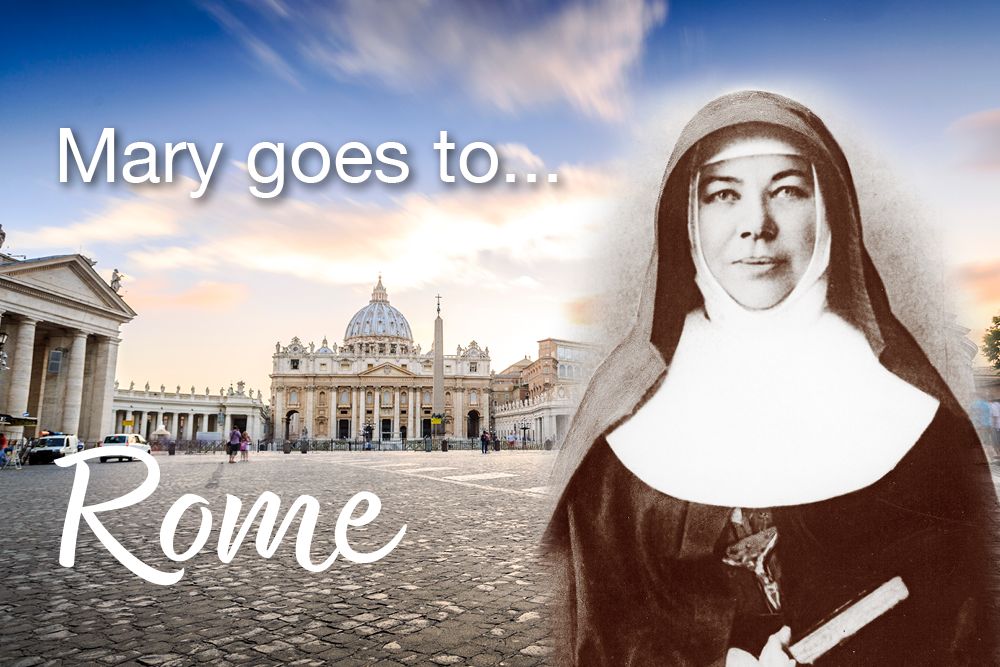
To celebrate 150 years since Mary MacKillop embarked on her first overseas journey (March 1873 – December 1874), the Sisters of Saint Joseph share reflections and details from Mary’s travels to and from Europe – sourced from Mary’s letters and Congregational Archives as she visits Italy, Germany, Scotland and Ireland.
“I am going to Rome… and I go full of hope!” Thus, wrote Mary MacKillop to her sisters on 25 March 1873. It reads like a simple statement but hides a wealth of grief, anxiety, hope and a profound trust in the Providence of God, her good God whose “adorable will” she encourages her sisters to accept in “humble submission… and in all circumstances whether pleasing or not to your natural inclinations”.[1]
Three days after she wrote this letter, Mary left Adelaide, South Australia, on the ss Rangatira for the first leg of her journey dressed as a widow, Mrs McDonald by name. She told her sisters, “I will not conceal from you the many perils, many crosses and contradictions which attend this undertaking – many things which might discourage – were it not for a certain sense of God’s watchful love which wonderfully strengthens me”.
These words of Mary had a prophetic ring to them. She was conscious of God’s watchful love from the very beginning of her journey. She knew that her uncle, Sandy Cameron and his wife Ellen, were on the way to Europe but Mary did not know where to meet them at her first stop in Albany, Western Australia. They, unexpectedly, walked past her window, joined her on board the ss Bangalore, cared for her on the journey to Galle in Ceylon (now Sri Lanka) and on to Bombay (now Mumbai).
From Bombay they travelled on the ss Golconda to Suez, then by train to Alexandria to join the ss Simla to Brindisi, an overall journey of more than 8000 miles. During the 45 days on four ships and two trains (from Suez to Alexandria and Brindisi to Rome) Mary was constantly aware of being loved by God through the people she met.
During the journey, a childhood friend contacted her and is believed to have enabled her to get her passport in Brindisi and a hotel in Rome. When she reached Rome, alone and unable to speak the language, she met Monsignor Kirby a priest recommended to her by Fr Reynolds of Adelaide. Her letters to Kirby give wonderful insight into her life and spirituality. He became the conduit for her to the Holy See where she was able to have the Rule for the Institute examined and re-written to conform to Vatican requirements.
Kirby was responsible for her meeting Pope Pius IX not once but three times, an extraordinary privilege, as she recounts, from the Pope who was suffering severely in the political situation of the day. While in Rome, Mary did not receive final approval for the Institute (Sisters of Saint Joseph), but she did receive encouragement from many. She returned with a version of the Rule that was to be lived and adapted where necessary. (It was finally approved in 1888.)
Mary’s confidence in the loving providence of God did not mean that she did not suffer. She battled with loneliness, isolation and ill health made worse by the intense humidity of the Roman summer. She, nevertheless, used her time to pray, visit significant churches and shrines in Rome and write numerous letters.
Her deep sense of hope and her cheerful acceptance of what she called her ‘trials’ helped her to become the saint whose holiness was recognised on 17 October 2010 when Pope Benedict XVI declared her a saint, not only the first canonised saint for Australia, but one for the universal church.
Maria Casey rsj
[1] Mary MacKillop’s letter from Adelaide to her sisters, 25 March 1873.
